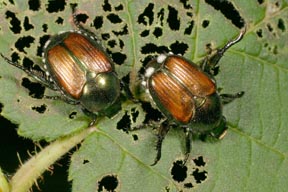Japanese Beetle Identification and Habits | |
|---|---|
| June 26, 2007 | |
|
Adult Japanese beetles are stocky and range from about 3/8 to 1/2 inch long. They are metallic green with coppery wing covers. There is a row of white spots along each side of the abdomen just below the wing covers, as well as two white spots on the back end of the abdomen. These white spots consist of patches of white setae (hairs). Males tend to emerge first and are strongly attracted to newly emerging females. It is common on turf to observe “balling,” a spherical mass 1 to 2 inches in diameter consisting of male Japanese beetles with a female Japanese beetles in its center. This “balling” typically occurs as the females are emerging in late June in central Illinois, earlier in southern Illinois, and later in northern Illinois.  Japanese beetle adults on grape. Mated females tunnel into the soil to lay eggs, preferring moist soil and apparently green, actively growing grass. The white grubs that hatch feed on turfgrass roots from early August until the turfgrass root zone soil temperature drops below 60°F. The grubs then tunnel deeper into the soil for the winter, returning to feed on turf roots when the temperature in that area rises to 50°F. The larvae pupate later in the spring, emerging as adults in June to early July, depending on latitude. Adult beetles feed on the upper, sunlit leaves of smartweed, linden, crabapple, birch, willow, rose, grape, brambles, and many other trees and shrubs. They typically feed through the upper leaf surface and the internal mesophyll, leaving the lower surface or epidermis intact. Although damaged leaves are initially whitish, the exposed lower epidermis soon turns brown. The beetles also eat holes through the leaves, as well as eat the leaf margins. This damage can be heavy enough that the upper portion of the tree or shrub is stripped of leaves. Damage in high-emergence areas typically causes all the leaves on small trees and shrubs to turn brown or fall off, and the upper half of the crown of medium-sized trees such as crabapples to have brown or no leaves. The beetles are present in large numbers for about6 weeks, becoming much less common around mid-August. Individuals can be found into early October, and there is evidence that small numbers of adults emerge in late summer. The adult beetles tend to fly to new hosts about every 3 days. This flight is commonly 3/4 to 1-1/2 miles. For this reason, controlling the adults to reduce the injury caused by their larvae to turfgrass is not effective. Similarly, controlling white grubs in turf to reduce leaf-feeding by the adults is not recommended. Control only the stage that is causing damage. When treating for adults, protect only those ornamental plants where the damage will be obvious, such as small trees and shrubs near entrances to buildings. It is usually not practical, nor economical, to try to protect all of the attacked plants in the landscape. Avoid treating plants where the damage will be less noticeable. |